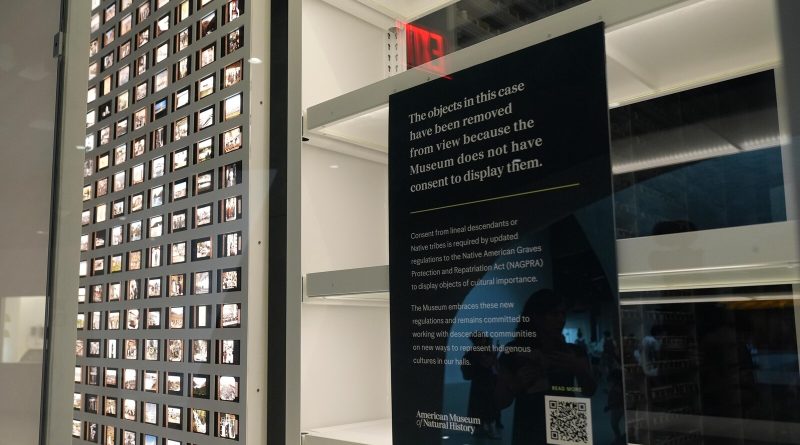Six months later, museums have yet to return Native American exhibits to tribes
NEW YORK — Housed within the vast halls dedicated to Indigenous peoples at the American Museum of Natural History is a small wooden figurine that holds a revered position among the tribes who once inhabited Manhattan.
For over half a year now, the ritualistic Ohtas, or Doll Being, has been concealed from public view as the museum and other institutions nationwide have taken bold actions to secure or cover up displays in compliance with new federal regulations mandating the return of sacred or culturally significant objects to tribes, or at least obtaining consent to exhibit or study them.
The figurine, also known as Nahneetis, is just one of approximately 1,800 items that museum officials claim they are reassessing as they strive to adhere to the regulations while considering a broader revamp of exhibits that have been in place for more than 50 years.
However, some tribal leaders remain doubtful, asserting that museums have been slow to act. After all, the regulations were enacted in response to years of grievances from tribes that hundreds of thousands of items that should have been returned under the Native American Graves Protection and Repatriation Act of 1990 are still in possession of museums.
“If progress is slow, then address that,” said Joe Baker, a resident of Manhattan and a member of the Delaware Tribe of Indians, descendants of the Lenape peoples who European traders encountered over four centuries ago. “The collections are part of our narrative, part of our lineage. We want them returned. We want them nearby.”
Sean Decatur, the president of the New York museum, assured tribes that they will be contacted by officials soon. He mentioned that staff members have been reevaluating the exhibited objects in order to initiate communication with tribal communities.
The museum also intends to launch a small exhibit in the autumn that will incorporate Native American perspectives and elucidate the history of the closed halls, the rationale behind the changes, and the future direction, according to Decatur.
Museum officials have a vision of completely renovating the closed Eastern Woodlands and Great Plains halls — similar to the five-year, $19 million refurbishment of its Northwest Coast Hall, accomplished in 2022 in close collaboration with tribes, Decatur added.
“The main objective is to ensure that we accurately convey the narratives,” he said.
Lance Gumbs, the vice chairman of the Shinnecock Indian Nation, a federally recognized tribe in New York’s Hamptons, expressed concerns about the absence of representation of local tribes in public institutions, with closures of exhibits likely to extend for years.
The American Museum of Natural History, he pointed out, is a major tourist attraction in New York and a staple for generations of local students learning about the tribes of the region.
He proposes that museums utilize replicas crafted by Native peoples to avoid physically displaying culturally sensitive items.
“I don’t believe tribes want to see our history excluded from museums,” Gumbs said. “There must be a more suitable approach than using artifacts that were essentially stolen from burial sites.”
Gordon Yellowman, who leads the department of language and culture for the Cheyenne and Arapaho Tribes, suggested that museums should focus on creating more digital and virtual exhibits.
He mentioned that the tribes in Oklahoma will be requesting from the New York museum a sketchbook by the Cheyenne warrior Little Finger Nail that contains his sketches and illustrations from battle.
The book, which is currently stored and not on exhibit, was taken from his body after he and other tribe members were killed by U.S. soldiers in Nebraska in 1879.
“These sketches were not merely made for aesthetic purposes,” Yellowman stated. “They were created to depict the actual history of the Cheyenne and Arapaho people.”
Institutions elsewhere are adopting alternative strategies.
In Chicago, the Field Museum has established a Center for Repatriation after concealing several displays in its halls dedicated to ancient America and the peoples of the coastal Northwest and Arctic.
The museum has also returned four items to tribes, with three more pending, through initiatives that were initiated prior to the new regulations, according to spokesperson Bridgette Russell.
At the Cleveland Museum in Ohio, a case displaying artifacts from the Tlingit people in Alaska has been reopened after their leadership provided consent.
And at Harvard, the Peabody Museum’s North American Indian hall reopened in February after approximately 15% of its collection of around 350 items were removed from exhibits, according to university spokesperson Nicole Rura.
Chuck Hoskin, chief of the Cherokee Nation, stated that many institutions now grasp that Indigenous items should not be treated as mere curiosities from “extinct peoples.”
The leader of the tribe in Oklahoma mentioned that he visited the Peabody this year following the university’s outreach regarding the return of hair clippings collected from Indigenous children in the early 1930s, including Cherokees, who were compelled to assimilate in the infamous Indian boarding schools.
“The fact that we can now have meaningful discussions with Harvard, that’s a step forward for the nation,” he remarked.
As for Baker, he desires the Ohtas to be returned to its tribe. He emphasized that the ceremonial figurine should never have been exhibited, particularly in the manner it was displayed among everyday items like wooden bowls and spoons.
Museum officials stated that dialogues with tribal representatives commenced in 2021 and will persist, even though the figurine technically does not fall under federal regulations as it is associated with a tribe outside the U.S., the Munsee-Delaware Nation in Ontario.
“It possesses a spirit. It’s a living entity,” Baker articulated. “So, envision it hanging on a wall in a stagnant case all these years, suffocating from lack of air, it’s truly horrific.”
___
Follow Philip Marcelo at twitter.com/philmarcelo.

